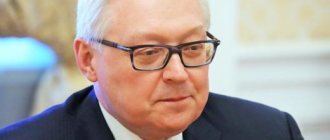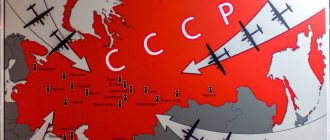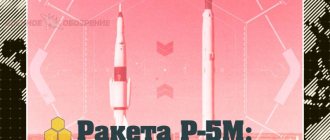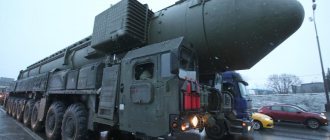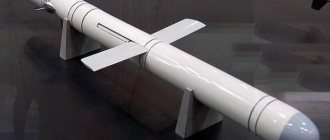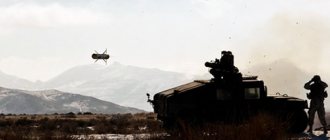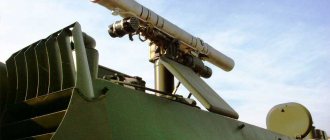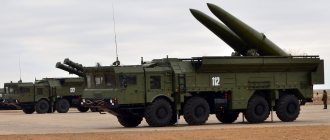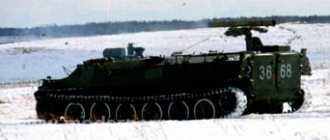"SS-20" redirects here. For other uses, see CC-20 (disambiguation).
Type of medium-range ballistic missile
| RSD-10 Pioneer SS-20 Saber | |
| Type | Medium-range ballistic missile |
| Place of origin | Soviet Union |
| Service history | |
| In service | 1976 – 1988 |
| Used | Soviet Strategic Missile Forces |
| Production history | |
| Designer | Alexander Nadiradze (Moscow Institute of Thermal Engineering) |
| Manufacturer | Votkinsk Machine-Building Plant |
| Characteristics | |
| Weight | 37,100 kg (81,800 lb) |
| Length | 16.5 m (54 ft) |
| Diameter | 1.8 m (5 ft 11 in) |
| Warhead | Three 150 MIRV |
| Engine | Two-stage solid fuel rocket[1] |
| Operational classify | 5,500 km (3,400 mi) |
| Guide system | Inertial |
| Accuracy | 150-450 m CEP |
| Launch Platform | Road mobile TEL |
The RSD-10 Pioneer
(Russian: medium-range missile (RSM) "Pioneer" tr.:
medium-range missile (RSM) "Pioneer"
; English: Intermediate-range missile "Pioneer") was a medium-range ballistic missile with a nuclear warhead deployed by the Soviet Union from 1976 to 1988 year.
GRAU designation 15Ж45
(
15Ж45
).
Its NATO reporting title was SS-20 Saber
.
Its deployment was the main reason for the "Bilateral Solution", which led to the deployment of more medium-range nuclear weapons in Western Europe. The RSD-10 was withdrawn from service in 1987. Intermediate-Range Nuclear Forces Treaty.
Characteristics
The missile was 16.5 meters (54 ft) tall, 1.9 meters (6.2 ft) in diameter, and weighed 37.1 tons. It was based on two solid-fuel glass-clad stages of the RT-21 Temp 2S (SS-16 Sinner
), therefore it was also known as
the RT-21M
Pioneer . The missile's original range was 600 to 5,000 kilometers (370 to 3,110 mi); the latter model had a maximum range of perhaps 7,500 kilometers (4,700 mi). Initially, the rocket was equipped with a single rocket. megaton, Warhead 1.6 t. Later models could take one or two (and since 1980 three) additional 150 kilotons. MIRV devices (Pioneer UTTH). The CEP was also reduced from 550 meters (1,800 ft) to 150 to 450 meters (490 to 1,480 ft). The missile was the first Soviet missile to be equipped with solid propellant instead of liquid, meaning it could be launched after the order was given, rather than having to spend hours doing the dangerous job of fueling the missile with liquid fuel.[2]:241
The missile used a MAZ-547A/MAZ-7916 transporter assembly launcher produced in the Byelorussian SSR through the Minsk Automobile Plant. TEL was originally developed for the RT-21 Temp 2C intercontinental ballistic missile.
On August 10, 1979, testing of the modernized Pioneer -UTTH (15Zh53) began at the Kapustin Yar training ground. This continued until August 14, 1980, and the SS-20 Mod3 missile was deployed on December 17, 1980. This variant had the same propulsion system as previous versions, but by modernizing the command staff and instrumentation, it was possible to increase the accuracy (CAO) from 550 to 450 meters, increase the maximum range by 10% and increase the area covered by the warheads.[3] This final RSD-10 variant subsequently received the NATO reporting name SS-28 Saber 2
.[4]
The reality of smart driving.
The SPH-10BT Pioneer Smartphone Receiver* is designed to provide secure and easy access to smartphone apps using four dedicated buttons. Safe driving is ensured by options such as voice recognition. The new Pioneer Smart Sync app adds additional lighting, tuning, and perfect sound features. Connect your smartphone via the built-in functional cradle and activate the free Pioneer Smart Sync app, which works in both wired and wireless modes to give you the full smart driving experience. The system is designed specifically for easy and safe driving: one-touch access to all applications and voice control of many functions.
Dynamic development of smartphone functionality and relaxation while driving. The SPH-10BT Pioneer system provides enhanced smartphone functionality, optimal accessibility, enhanced gaming capabilities and high-quality sound. There is nothing better for the modern lifestyle.
*Smartphone is not included.
Development
It was intended to replace or augment the R-12 Dvina (SS-4 Sandals
) and R-14 Chusovaya (SS-5
Skin
) missiles deployed from 1958 and 1961 respectively in the USSR and Warsaw Pact states. It entered the development stage in 1966.[5] and in 1968 the design concept was approved with the assignment of the Moscow Institute of Thermal Engineering and Alexander Nadiradze, who also developed the RT-21 Temp 2C in the same period. Flight testing began in 1974 and deployment began on March 11, 1976, with the first units delivered entering service in August of that year. Until 1986, a total of 48 launch sites, including the Pavshchino site, were equipped with 405 RSD-10 missiles under the control of the Strategic Missile Forces.
There have been several theories as to why the Soviet Union developed the SS-20:
- Some in the United States, such as Richard Perle, viewed the SS-20 as part of the Soviet Union's attempt at global power.[2]:243
- Another popular theory was that the SALT treaties, which placed quantitative restrictions on long-range missiles, encouraged the Soviets to pay more attention to intermediate-range missiles, which were not covered by SALT.[2]:244
- Another theory was that the SS-20 was the "son" of the failed SS-16 ICBM project. After the failure of the SS-16, the Soviets simply used technology and parts that were developed for the SS-16 for the SS-20.[2]:244
- Others argued that the SS-20 was part of the Soviet military's attempt to develop a more sophisticated nuclear strategy that did not require a nuclear first strike immediately after the outbreak of World War III, giving the Soviets a second strike. striking ability they previously lacked.[2]:244
In the 1960s, Soviet missile procurement was dominated by the ideas of Defense Minister Marshal Andrei Grechko, who was opposed to the idea of nuclear weapons as a weapon of last resort and planned that if World War III broke out, that conflict would begin with an immediate nuclear strike on NATO countries.[2] :245 By the early 1970s, Grechko's views attracted opposition from military and political leaders who wanted the Soviet Union to have a second strike capability to prevent the war with the United States from immediately turning nuclear, as Grechko preferred.[2]:245– 247 More importantly, the growing influence of Marshal Dmitry Ustinov marked a shift in Soviet thinking about nuclear weapons.[2]:247 Ustinov was a man closely associated with various Soviet design bureaus and generally supported the design bureaus' demands against the military regarding weapons procurement. [2]:250–251 The decision to order and introduce the Pioneer in the mid-1970s was largely due to Ustinov's desire to transfer military procurement from the hands of the military to the design bureaus, which in turn insisted on increasing and diversifying weapons. increasing orders.[2]:251–252 British historian James Kant wrote that it was the triumph of the Soviet version of the military-industrial complex over the military in terms of arms purchases that was the most important reason for Pioneer.[2]:251–252
LIFE
The Pioneer Group of Companies has created a whole concept of modern urban residential areas, and the developer is carefully and quite successfully implementing it. What does the laconic name “LIFE” hide?
The fact is that it was not chosen for the sake of a beautiful word. Each letter in the word reveals one or another side of the project, which organically fits into its concept
Location
. "Pioneer" relies on the optimal location of the quarter relative to important infrastructure facilities, transport hubs and arteries. Simply put, its complexes are always in the center of city life, and nearby there is everything you need to live and work.
Innovation
. Pioneer claims to use the latest technologies in the design and construction of facilities. For example, for the exterior decoration of buildings in the LIFE-Kutuzovsky residential complex, European clinker bricks were used - not only environmentally friendly, but also resistant to fires and weather vagaries.
Family
. Everything is clear here - the developer is relying on the comfort of people and families. Therefore, it creates and actively develops social and commercial infrastructure within Life quarters. A garden nearby, a school across the road - all this is included in the concept of the project. For example, in November 2022, in the LIFE-Botanical Garden residential complex, not only the 9th residential building was put into operation, but also an educational complex, including both a kindergarten and a high school.
Ecology
. It sounds, of course, beautiful, and the goal is noble - to create neighborhoods away from hazardous industries and near green areas. As far as possible in the Mother See, the developer is trying to implement this principle. For example, next to “LIFE-Kutuzovsky” the Setun River flows, framed by green spaces. And “LIFE-Botanical Garden” speaks for itself - the vast Main Botanical Garden of the Russian Academy of Sciences is nearby.
The concept of LIFE quarters also includes spacious underground parking lots, courtyards where cars are not allowed to enter, and high-quality finishing of the apartments. However, judging by the reviews, there are problems with the latter. But more on that later.
Deployment
RSD-10
missile and its transporter mounting launcher
While the Warsaw Pact may have had enormous conventional superiority over NATO in Central Europe, the Soviet leadership assumed that NATO would use tactical nuclear weapons to stop a massive Warsaw Pact offensive.[6] The RSD-10 provided the Soviet Union with a "selective" theater targeting capability that it had previously lacked. The RSD-10 was capable of destroying all NATO bases and installations with little warning. Thus, the Soviet Union was able to neutralize NATO tactical nuclear forces using surgical nuclear strikes.
In 1979, NATO decided to deploy the US Pershing II and BGM-109G ground-launched cruise missiles to Western Europe in an attempt to counter the RSD-10. In 1979, when the NATO decision was made, the Soviet Union had 14 (1 operational) SS-20 launch sites.
Literature[ | ]
- Kolesnikov S.G.
Strategic nuclear missile weapons. - M.: Arsenal-Press, 1996. - Karpenko A.V.
Domestic strategic missile systems. - M., 1996. - Ground-based strategic missile systems. - M.: Military Parade, 2007. - 248 p. — ISBN 5-902975-12-3.
- Trembach E. I., Esin K. P., Ryabets A. F., Belikov B. N.
“Titan” on the Volga. From artillery to space launches / Under the general editorship. V. A. Shurygina. - Volgograd: Stanitsa-2, 2000. - 176 p. — 1000 copies. — ISBN 5-93567-014-3, BBK 63.3(2)6.
Removal from service
RSD-10 Pioneer rocket with return bodies next to Pershing 2 at the National Air and Space Museum
A total of 654 rockets were built. These and 499 associated mobile launchers were destroyed by May 1991 in accordance with the Intermediate-Range Nuclear Forces Treaty. Fifteen SS-20s, eight BGM-109G Griffons, and seven Pershing II missiles were retained to commemorate this agreement. One RSD-10 can be seen on the grounds of the Great Patriotic War Museum, Kyiv, one at the Ukrainian Air Force Museum in Vinnitsa, Ukraine, and another is located inside the Smithsonian National Air and Space Museum in Washington, DC, US.
North Korea has acquired an unknown number of demilitarized SS-20 transporter mounting launchers from Russia or Belarus for use with the BM25 Musudan missile.[7]
SMART
The developer also called one of the LIFE quarters – “LIFE-Varshavskaya” – a SMART quarter. This buzzword, in this case, implies a special approach to the concept and technological equipment of the object.
By the word “SMART” in this case, the developer means the following:
Smart living
.Eco-friendly technologies that allow you to control and save energy resources (individual regulation of the level of heat in the room, lighting, etc.).
Smart comfor
t. The latest security systems, ensuring privacy and maximum convenience for residents. Modern concierge service. Access control and emergency notification.
Smart environment
. It consists of caring for the health and comfort of residents. In fact, this is the installation of game and sports complexes from leading manufacturers in courtyards, landscape design of local areas.
The Smart concept assumes the presence of a Smart Home platform. Among other things, it will recognize family members and guests, turn on the panic button, adjust the lighting level and climate in the apartment.
Recommendations
- https://missilethreat.csis.org/missile/ss-20-saber-rsd-10/
- ^ a b c d f f gram h i j k
Kant, James (2005).
“SS-20 rocket - Why were you pointing at me?” In Erikson, Lubica; Erickson, Mark (ed.). Russia: War, Peace and Diplomacy
. London: Weidenfeld and Nicholson. pp. 240–253. ISBN 978-0-297-84913-1. - "RT-21M / SS-20 SABER - Russia / Soviet Nuclear Forces." Retrieved December 23, 2014.
- “INF Theater / Operational Missiles - Russia / Soviet Nuclear Forces.” Retrieved December 23, 2014.
- "RSD-10 Mod 1 / -Mod 2 (SS-20)." Missile threat
. Archived from the original on August 28, 2016. Retrieved December 23, 2014. - ISN editors. "Poland Reveals Warsaw Pact War Plans." International Relations and Security Network
. Retrieved December 23, 2014. - Nick Hansen (4 May 2012). "North Korea's New Long-Range Missile - Fact or Fiction." 38 North
. Retrieved April 12, 2013. - Michael Holm, 23rd Guards Missile Division, as of July 2013
"Pioneer" effect
Main article: Pioneer effect
When studying the movement of the automatic interplanetary stations “Pioneer-10” and “Pioneer-11”, their slight deviation from the calculated trajectories towards the Sun was revealed. The nature of the deviation indicated that there was an unknown factor, very weakly, but continuously slowing down the vehicles moving away from the Sun. This phenomenon was called the “Pioneer” effect. It was not possible to explain it by the action of external forces on the Pioneers, and the assumption that the effect originated due to the design features of the devices was initially considered unfounded. Various assumptions have been made about the nature of the effect, including the imperfection of the main cosmological theories. Later, more detailed analysis of telemetry data and computer modeling confirmed the asymmetry of the thermal radiation of Pioneer 10 itself as the reason for its braking, and a similar conclusion was made for Pioneer 11.
About the launcher
The main elements of the Pioneer missile system are represented by the 15Zh45 ballistic missile and the 15U106 self-propelled launcher. Due to this architecture, with the help of the PGRK it was possible to patrol at a great distance from the base, and upon receiving an order, launch a missile in a short period of time. The self-propelled launcher was created by employees of the Volgograd Central Design Bureau "Titan". As the basis for the vehicle, engineers used the MAZ-547V chassis, which has a 12 x 12 wheel arrangement.
15U106 was more than 19 m long and weighed 80 tons (if a transport and launch container and a missile were installed on it). The presence of a V-38 diesel engine, designed for 650 horsepower, made it possible to accelerate the unit to 40 km/s on a flat road. According to experts, the 15U106 was capable of overcoming inclines of up to 15 degrees, three-meter ditches, and crossing water obstacles if the depth did not exceed 1.1 m. In order to be able to place a transport and launch container (TPC) on the installation and lift it vertically before launching the rocket, The car was equipped with a lifting unit. It could be controlled using hydraulic drives.
How did the complex work?
The cold method was used to launch the Pathfinder rocket. The bottom part of the container was equipped with a powder charge, due to the combustion of which the rocket was ejected from the Complex. In an effort to improve the design, engineers decided to combine the powder source with a separate cylindrical element. In other words, it turned out to be a retractable cup inside the container. When the rocket was launched, the powder gases also affected the “glass”. As a result, it sank into the ground, thus forming additional support for the entire transport and launch container. This part also served another purpose. In the event of abnormal combustion of a charge, as if it could harm the rocket, the pressure inside the container was relieved using a “glass”. Confinement of the rocket inside the TPK was carried out by detachable support-driving belts (OSB), which were used as a shutter. After the rocket took off, these belts were fired. As a result, they scattered to the sides, retreating from (five fathoms) up to 170 m. According to experts, because of this feature, it was impossible to carry out a group launch on one site. Otherwise, the launching PGRK would damage surrounding objects as much as possible.
Design
Diagram of the Pioneer-10 device
- energy source - radioisotope generators
- electronics compartment.
- communication with the Earth - through a parabolic antenna with a diameter of 2.75 meters
The device carried the following scientific instruments:
- plasma analyzer,
- charged particle detector,
- set of Geiger counters,
- cosmic ray detector,
- radiation detector, ultraviolet photometer,
- imaging photopolarimeter,
- infrared radiometer,
- a set for observing meteoric matter and a set of meteor particle detectors.
The mass of the apparatus was 260 kg, including 30 kg of scientific instruments; height - 2.9 m, maximum transverse size (diameter of the highly directional antenna reflector) - 2.75 m. The images transmitted by the device had low resolution, since they were taken not by a camera, but by a photopolarimeter, which had a very narrow field of view (0. 03 degrees). Scanning along one coordinate occurred due to the rotation of the spacecraft, and along the other - due to its movement in orbit.
Images of the Galilean satellites transmitted by Pioneer 10
| This section is not completed. You will help the project by correcting and expanding it. |
About TPK
Engineers used fiberglass as a material for the manufacture of the 15Ya107 transport and launch container. In order to make the TPK stronger, it was reinforced with titanium rings. The container had a multilayer structure, namely, two fiberglass cylinders were separated by a heat-insulating layer. The length of the TPK turned out to be no more than 19 m. A hemispherical cover was attached to the front (upper) end with pyrobolts. For a mortar launch of a rocket, the rear (lower) end of the container was equipped with a PAD housing (powder pressure accumulator).
"Interstellar Letter" of Pioneer 10
Main article: Pioneer records
An anodized plate made of durable aluminum alloy was installed on the body of the device. The dimensions of the plate are 220x152 millimeters. The author of the drawing is Carl Sagan.
The plate shows:
- neutral hydrogen molecule;
- two human figures, men and women, against the background of the outline of the apparatus;
- the relative position of the Sun relative to the center of the Galaxy and the fourteen pulsars;
- schematic representation of the Solar system and the trajectory of the vehicle relative to the planets.
An anodized aluminum plate on board Pioneer 10. The hydrogen molecule is shown as consisting of two atoms with different spins.
The distance between the centers is proportional to the wavelength of neutral hydrogen radiation (21 centimeters). This number is a scale ruler for finding other linear quantities on the plate. The height of the people on the plate can be found by multiplying the number 8 (engraved in binary code next to the figure of the woman in square brackets) by 21. The dimensions of the apparatus in the background are given on the same scale. Fifteen lines diverging from a single point make it possible to calculate the star from which the device arrived and the launch time. Next to the fourteen lines is a binary code that indicates the period of pulsars located in the vicinity of the Solar System. Since the period of pulsars increases over time according to a known law, it is possible to calculate the launch time of the device.
On the diagram of the Solar System, next to the planets, the relative distances from the planet to the Sun are indicated in binary form.
Criticism of the message
Many of the symbols in the picture may be incomprehensible to another mind. In particular, such symbols can be square brackets framing binary numbers, an arrow sign on the flight path of Pioneer 10, and a man’s raised hand in greeting.
Rating and awards
As you know, there are many rating systems, including both domestic and international. Here we present the indicators of only some of them – the most significant ones.
- Since October 2015, the Group has had a credit rating of “A+” according to the national rating agency.
- The international agency Standard & Poors changed the developer’s rating from “stable” to “positive” (2018).
- The long-term credit rating of Pioneer Group of Companies is “B” (the same “Standard & Poors”, the same year 2022 - the rating is confirmed).
- The credit rating according to the Russian agency RAEX is ruBBB, the forecast is stable. This means that the developer has a moderate level of creditworthiness, financial reliability and stability.
In recent years, Pioneer Group of Companies has received the following awards:
- Award “Real Estate Market Records 2016”: the residential quarter “LIFE-Mitinskaya ECOPARK” took first place in the category “Infrastructure of Object No. 1”.
- Federal PROESTATE AWARDS: “Best of 10 years”: the chain of apart-hotels “YE'S” is a finalist in the category “Best Innovation of the Decade”.
- RREF Awards 2016: Pioneer Group of Companies was recognized as Developer of the Year according to the RREF Awards 2016.
- UrbanAwards 2016: residential quarter "LIFE-Botanical Garden" - winner in the category "Best comfort-class residential complex under construction."
- BREEAM: business awarded BREEAM Final certificate with a final rating of Good.
- PROESTATE AWARDS 2022: the LIFE-Botanical Garden quarter is the winner of the Federal PROESTATE AWARDS 2022.
- GREEN AWARDS: business took second place in the GREEN AWARDS 2022 ranking.
- RREF Awards 2022: Pioneer Group of Companies – developer of the year.
- REAL ESTATE MARKET RECORDS 2022: “LIFE-Kutuzovsky” – new building in Moscow No. 1.
- PROESTATE&CRE FederalAwards 2022: “LIFE-Botanical Garden” quarter – winner in the “Comfort-class residential project” category. Moscow".
- RREF Awards 2022: apart-hotel "YE'S Technopark" - first place in the category "City Construction. Apartments (Moscow)".
- Apartment complex “First Line. Apartments” is the best in the “Country Housing” category. Comfortable environment."
- URBAN AWARDS 2022: “LIFE-Kutuzovsky” is the best business class project under construction in Moscow.
- "YE'S Botanical Garden" is the best complex of comfort-class apartments.
- Four-time winner of the VTB Bank business award.
- As a result of an independent assessment of the developer’s work, Moscow State Expertise awarded him a high reliability rating.
GC "Pioneer" and its components
- "Pioneerdevelopment"
. Subdivisions exist in Moscow and St. Petersburg. Area of responsibility is everything related to the design and construction of facilities. - "PioneerService"
. Responsible for the management and operation of facilities. - "Pionerstroy Invest"
is a limited liability company that is engaged in architectural design, engineering surveys and consulting in these areas. We work in Moscow. - "Pioneer Invest"
is a limited liability company engaged in the purchase and sale of real estate owned by the Pioneer Group of Companies. Works in St. Petersburg. - PioneerConstruction
is the general contractor. Carries out installation and construction, commissions finished facilities, and works with permitting documentation. - “PioneerProduction”
is an organization that controls the production of plastic windows at a plant owned by the Pioneer Group of Companies.
Top managers. Who is who?
"Pioneer" is a closed joint stock company, it was founded in 2001. The Chairman of the Board of Directors is Andrey Yuryevich Grudin. He has a technical and economic education, and also graduated from the Moscow School of Management Skolkovo. He holds the title “Honorary Builder of the City of Moscow.” Until 2001, he managed and was a shareholder.
Leonid Vladislavovich Maksimov – General Director of Pioneer Group of Companies. Graduated from the Moscow State Geological Prospecting Academy. Since 1993, he has been engaged in entrepreneurship and management in trade, construction and investment. One of the creators (a subsidiary of the Magnitogorsk Iron and Steel Works). Currently working in the field of strategic development and development of promising areas at Pioneer Group of Companies.
Design Features
- The R-36M is a two-stage missile using sequential stage separation. The fuel and oxidizer tanks are separated by a combined intermediate bottom. The onboard cable network and pipelines of the pneumohydraulic system, which are covered with a casing, run along the body. The 1st stage engine has 4 autonomous single-chamber liquid propellant engines, which have a turbopump fuel supply in a closed circuit; they are hinged at the rear of the stage on the frame. Deflection of the engines at the command of the control system allows you to control the flight of the rocket. The 2nd stage engine includes a single-chamber propulsion engine and a four-chamber steering rocket engine.
- All engines run on nitrogen tetroxide and UDMH. The R-36M implements many original technical solutions, for example, chemical pressurization of tanks, braking of the separated stage using the exhaust of boost gases, and the like. The R-36M is equipped with an inertial control system, which operates thanks to an on-board digital computer complex. Its use allows for high shooting accuracy.
- The designers provided for the possibility of launching the R-36M2 even after an enemy nuclear strike on the area where the missiles are located. "Satan" has a dark heat-protective coating that facilitates passage through the radiation dust cloud that appears after a nuclear explosion. Special sensors that measure gamma and neutron radiation during the passage of the nuclear “mushroom” register it and turn off the control system, but the engines continue to operate. After leaving the danger zone, the automation turns on the control system and corrects the flight path. ICBMs of this type had particularly powerful combat equipment. There were two variants of the warhead: MIRV IN with eight warheads (900kt each) and a monoblock thermonuclear one (24Mt). There was also a complex for overcoming missile defense systems.
Video about the Satan rocket
https://youtube.com/watch?v=nwFP_slb1g0
https://youtube.com/watch?v=nwFP_slb1g0
Author of the article:
Nikiforov Vladislav

